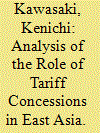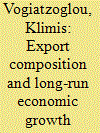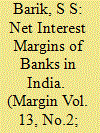|
|
|
Sort Order |
|
|
|
Items / Page
|
|
|
|
|
|
|
| Srl | Item |
| 1 |
ID:
164421


|
|
|
|
|
| Summary/Abstract |
While many studies focus on the impact of trade agreements, the literature has not focused on the extent of their implementation, in terms of the aspects agreed upon therein. In this article, we identify the past achievements of economic partnership agreements (EPAs) in the East Asian region in terms of tariff removals and suggest room for further economic benefits from trade liberalisation in the region. Second, we incorporate the HS6-level tariff concession dataset, which distinguishes between tariff removals agreed in these EPAs in East Asia but not yet implemented, from existing overall tariffs in 2011, in the Global Trade Analysis Project (GTAP) Database, which only incorporates enforced tariff reductions through the base-year applied tariffs. To analyse future trade integration, we include commitments that are not yet implemented. This allows us to analyse partial versus full enforcement of tariff concession commitments. Our results suggest that taking those commitments into account matters economically in East Asia.
|
|
|
|
|
|
|
|
|
|
|
|
|
|
|
|
| 2 |
ID:
164422


|
|
|
|
|
| Summary/Abstract |
Export expansion can be a significant engine of economic growth for developing economies. The size of the growth effect of exports depends not only on volume but also on the sectoral composition of exports. By explicitly considering the sectoral export composition, this article examines over a 31-year period the long-run growth impact of exports in four transition and emerging economies of the Association of Southeast Asian Nations (ASEAN), namely Cambodia, Laos, Myanmar and Vietnam. More specifically, for each country, a long-run equilibrium analysis within a cointegration framework is conducted for three broad sectors (agriculture, mining/natural resources and manufacturing) as well as for 22 manufacturing industries during 1987–2017. The results indicate that there has been sizeable export expansion (especially in Vietnam), but export composition differs substantially across economies, which has an effect on the overall growth impact of the country’s exports. Clear evidence of export-led growth is found only for some sectors. Countries that rely heavily on primary goods have experienced relatively lower export-led growth. Export restructuring in manufacturing industries is associated with a larger long-run growth effect for a country’s exports. Our findings suggest that policies encouraging diversification away from traditional export sectors would be expected to lead to higher long-run growth effects of exports. Furthermore, our analysis implies a steady strengthening of export dynamism in ASEAN ‘latecomer’ economies and their rising significance in the global trade system.
|
|
|
|
|
|
|
|
|
|
|
|
|
|
|
|
| 3 |
ID:
164424


|
|
|
|
|
| Summary/Abstract |
This article studies the impact of age structure variables on the current account balance (CAB) by using panel data for 57 countries from 1980 to 2014. The Gudmundsson and Zoega (Economic Letters 123[2]:183–186, 2014) methodology is used to calculate the age-adjusted CAB for these countries and India-specific results are analysed in comparison with Brazil, Russia, China and South Africa. Empirical results show that India’s age-adjusted CAB would have experienced surpluses had it not been for the high share of its dependent population, especially the young. Further, the age-adjustment factor for India shows a gradual decline, and a larger share of working-age population in future may help in reducing its current account deficit (CAD). These results highlight the importance of demographic variables in explaining and predicting changes in the CAB and its implication for the attainment of India’s macroeconomic objective of external stabilisation.
|
|
|
|
|
|
|
|
|
|
|
|
|
|
|
|
| 4 |
ID:
164423


|
|
|
|
|
| Summary/Abstract |
Net interest margin (NIM) is the raison d’être of banking. It is an important measure of efficacy of the banking sector. At the system level, it is indicative of the cost of financial intermediation, health of the banking sector and its pricing power. In recent years, the Indian banking sector has experienced a major metamorphosis, with increasing competition and changing norms of liquidity, income recognition and capital. The end of regulatory forbearance and asset quality review (AQR) unearthed significant non-performing assets. This article traces the influence of various factors on the NIM, using bank-level data for 42 Indian banks over 25 quarters from March 2011 to March 2017. The study employs a dynamic panel generalised method of moments (GMM) framework to trace the impact of three distinct set of factors in setting banks’ NIMs: bank-level factors (like the share of low interest-bearing deposits held, the extent of gross non-performing assets [GNPAs], the capital-to-risk weighted assets ratio [CRAR], size of the loan book, operating costs and lending rates); system-level factors such as the monetary policy rate, credit growth and yields on government securities and macro-variables such as GDP growth and inflation. The results indicate that the main determinants of NIMs are banks’ CRAR levels, the proportion of current account and savings account deposits (CASA) to total deposits, operating costs and size of the loan book. Macro-factors like the growth of the economy and repo rate have a positive influence on the NIM.
|
|
|
|
|
|
|
|
|
|
|
|
|
|
|
|
| 5 |
ID:
164425


|
|
|
|
|
| Summary/Abstract |
This article examines if there is a wage gap between public and private mining (and quarrying) workers in India, using the NSS data (2004–2005, 2009–2010 and 2011–2012). We employ linear and quantile regressions to estimate the wage gap. The ordinary least squares (OLS) results suggest that workers in the public sector mines (and quarries) earn 59 per cent more than their private sector counterparts. However, the wage gap is not uniform across the conditional wage distribution. The quantile regression estimates show that the magnitude of the wage gap is larger at the bottom quantile than at the top; the gap reduces as we move up the wage distribution. Observations drawn from our sub-sample analysis concur with these findings.
|
|
|
|
|
|
|
|
|
|
|
|
|
|
|
|
|
|
|
|
|